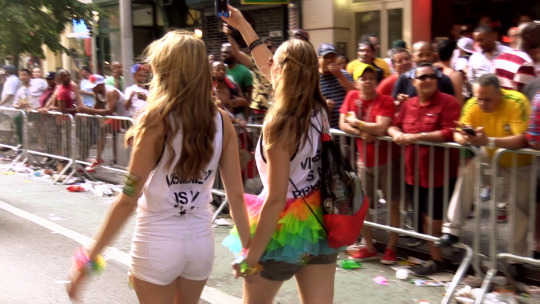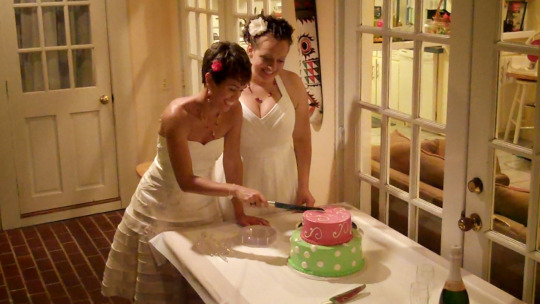Conversations | Jodi Savitz on “Girl on Girl” and Femme Invisibility
We talk with the Fiscally Sponsored filmmaker about her feature-length documentary that follows the stories of feminine lesbians.
There were moments in my late teens when I would occasionally wear Abercrombie distressed jeans with a ribbed tank-top in order to feel a bit ‘gayer’ […] it was never a style I wholly embraced or felt comfortable with. To me, femininity is just a part of my being and I could never imagine abandoning that facet of my identity. – Jodi Savitz
Jodi Savitz’s newly-released debut film and NYFA Fiscally Sponsored project explores the concept of femme invisibility. Through candid footage and shared narratives, Girl on Girl follows Lyndi, Karen, Kris, Lauren, Ashleigh, and Destini as they live their lives and face circumstances demonstrating the emotional consequences of invisibility.
Screened at a manifold of film festivals, selected as a ‘Films and Series Worth Seeing’ on Vimeo, and boasting a Facebook campaign of more than 475,000 fans, Girl on Girl and its resounding message has been a success. The film has not only fostered a community for those who face the challenges of femme invisibility, but has ultimately provided a universal narrative that everyone can connect with—a narrative signifying the respect for the humanity within each other.

Watch the trailer:
Now Streaming on Vimeo
Rent: $8.99 Buy: $14.99
NYFA: Can you share with us what the term ‘femme invisibility’ means? Do you consider yourself a femme lesbian and have you undergone transformation in your own gender representation as some of the characters have, from embracing boyish clothes to feminine dress?
Jodi Savitz: Feminine lesbian invisibility, or ‘femme invisibility,’ is the phenomena in which, indistinguishable from cisgender, heterosexual women, feminine lesbians are rendered invisible to the world and to each other. Put simply, to the casual observer, feminine lesbians ‘look straight’ and are assumed to be straight.
I consider myself a femme lesbian. In fact, the concept for Girl on Girl evolved out of my lived experiences and those of the women around me. As a child, I presented as feminine and enjoyed traditionally ‘girly’ toys and activities; I had a room full of Barbies, baby dolls, and dress-up clothes.
When I came out at age 14 I neither questioned my femininity nor interpreted it to be at odds with my lesbian identity. The majority of lesbians I knew growing up were proud to be feminine and gay—and even my more androgynous friends wore mascara.
Looking back, I attribute much of my femme identity to having been part of the Ft. Lauderdale and Miami Latina lesbian subcultures. The influence of bold, Latina femmes facilitated the growth of a visible and thriving lesbian community, and within that community, I developed my sense of agency.
While I’ll admit there were moments in my late teens when I would occasionally wear Abercrombie distressed jeans with a ribbed tank-top in order to feel a bit ‘gayer’ at a lesbian bar or Ani DiFranco concert, it was never a style I wholly embraced or felt comfortable with. To me, femininity is just a part of my being and I could never imagine abandoning that facet of my identity.

NYFA: The film addresses the challenges that femme lesbians face in a culture of heteronormativity but do they also face challenges of recognition within the LGBTQ community?
JS: In short, yes. Despite the queer community’s progressive façade, conflicts about lesbian identity exist just below the surface. Like in heteronormative culture, misogyny and internalized sexism exist, but unlike the explicit sexism lesbians might experience from straight men, the LGBTQ community exacts masculine privilege in a more nuanced way.
The everyday challenges of being a femme lesbian in the straight world include the feeling of not being seen, recognized, or taken seriously for who we are. Specifically, we are accused of not really being gay, told that we haven’t met the right man yet, are “too pretty to be gay,” or are a “waste” if we do not marry men.
In LGBTQ circles, a similar sentiment rings true, albeit feminine lesbians are accused of not being queer enough. Femme lesbians are called out for “conforming to the cisgender paradigm,” which leads to the misguided perception that because we are not visually subversive, we do little to enhance the visibility to the LGBTQ community. The rhetoric ‘passing privilege’ or ‘femme privilege’ is cited commonly—and ironically—as justification to dismiss femme lesbians’ concerns about the aggressions and micro-aggressions directed toward us.
NYFA: The six stories represented in the film are varied and geographically dispersed—how did you find each of these women? What are the common threads with each of their stories?
JS: Each cast member came to the film in an entirely different way. I initially used the Facebook community’s network to distribute a casting notice, and then distributed the notice through my personal networks. Here is a quick summation about how each woman came to join the Girl on Girl cast:
Lyndi, who moved between Orlando, Utah, and Key West over the course of filming, was the first to contact me, after hearing about the film through a friend of a friend.
After contacting me on Facebook, a young woman in Miami organized a group of her femme lesbian friends to meet with me for a group interview. Five women took part in the interview, and from that, Karen’s story stood out to me, and I invited her to join the cast.
On the same trip to Florida, I met Kris. I happened to take my camera to a local pride festival in Ft. Lauderdale, where the group Women in Action was working a booth. Several women spoke on camera about their organization and their experiences as femme women in the lesbian community. Kris spoke about her time as a lesbian-feminist activist and her personality and charisma led me to ask her to join the cast.
After The Real L Word ended, Lauren Russell became a popular figure in the lesbian community, and when I ran into her one night at a NYC lesbian bar, I decided to ask her directly if she might be interested in the film. She was. We sat down for coffee soon after, and she expressed her interest in promoting femme lesbian visibility. From there, she joined the cast.
Finally, after the initial casting notice, I posted a second notice that emphasized that I was looking to cast a lesbian couple who had a child and were planning to have a baby. I received several dozen submissions, and narrowed it down to my top ten. Each family submitted a video, and Ashleigh and Destini were part of that group. Everything about Ashleigh and Destini’s energy in their video made me love them, and Saibra’s charm made the choice easy!
The six women have one key thing in common: even after coming out, they often feel delegitimized for their femme identity and have experienced invisibility, even in LGBTQ spaces. Each woman has faced having to repeatedly defend her identity to a critical and skeptical world.
NYFA: You took a unique approach to filmmaking by providing your subjects with cameras, where they could film themselves (or each other if they were a couple). It worked out so well that it’s hard to even notice. Why did you decide to try this approach?
JS: Initially, the choice to rent cameras for the subjects to film themselves was about saving money. It was more economical to provide the cameras several times a year, than it was to travel on-location. But as I started to receive footage, it was clear that the cameras were having a distinct and awesome effect on each cast member, and I saw a unique opportunity to delve into their personal narratives further.
I very rarely gave instructions on how or what to film, so each subject took an individual approach. With little pressure and few constraints, the cast had the opportunity to film home movies whenever and wherever they wanted to. The cameras also allowed me to film holidays and special occasions in multiple places at once, and I was even able to capture the birth of Blythe at the very last minute! From hotel confessions and Christmas morning, to sonograms, song circles, and steamy (literally!) hot tub conversations helped authentically capture each subject’s emotional journey.

NYFA: What were your greatest obstacles you faced as you were creating this film? How did you overcome them?
JS: I walked into it knowing little about documentary filmmaking, and each step of the filmmaking process involved teaching myself something new. At a certain point, I made a decision to let go of the many preconceived ideas I had about filmmaking and ultimately redefined which milestones were meaningful to me. Looking back, I can truly say that each and every mistake was a lesson I’ll take with me!
Even with 475,000 followers and solid publicity, our efforts at crowdfunding wound up being more of a time-sucker. The unfortunate truth in the case of Girl on Girl seems to be that our target audience, while quick to lament the dearth of lesbian oriented content, is unlikely to ‘put their money where their mouth is.’ This obstacle extends to sales of the film. While plenty our fans express the huge impact of the GOG page in their lives, they simultaneously express frustration that the film is not free.
Another obstacle worth noting is the challenge of the film festival circuit. The LGBTQ circuit was less receptive to the film than I anticipated. As such, we decided to plan screenings outside of festivals, which ultimately sold out in New York and Los Angeles, each with over 200 people.
My most recent obstacle has been distribution. As a first time filmmaker, I found the commercial distribution process near impossible to infiltrate as a newbie, and eventually decided to forego finding a distributor altogether. Girl on Girl is currently available on Vimeo-On-Demand and Distrify, and I am still deciding whether or not to seek distribution on Netflix, Hulu, and iTunes. Everything comes down to cost—there are fees to pay aggregators that cost $1,000 – $2,000 per outlet—while it may not sound like much, in the end, without financial backing, the fees are quite prohibitive.
NYFA: The film has over 475,000 followers on Facebook! What tactics and strategies did you employ to develop such a following? Has the content of your film driven the marketing of it?
JS: The Girl on Girl Facebook page is a social media engagement anomaly that, while extraordinary, is not an accident. Initially, the purpose of the Facebook page was to gauge interest in the film’s subject.
Within weeks of launching, the page quickly evolved into a home for lesbians who sought a sense of community beyond their hometown or in lieu of it. As the page gained traction, it captured the attention of LGBTQ women all over the world. Messages began crowding the inbox, comment threads went into the thousands, and engagement each week would rise by millions—and it was 100% organic.
Over time, I developed a content strategy that not only seeks to engage my target audience, but also builds allies beyond our community, enhancing visibility, and actively energizing our fans to feel proud of who they are and whom they love. I curated content that I personally identified as moving and relevant to women in the community. “If I like it, I post it. If I don’t like it, I don’t post it” was my basic philosophy, and designing lesbian-oriented memes became an additional full-time job.
NYFA: I’m sure some people who look at your film think it is designed or should be seen by members of an LGBTQ ‘niche’ community. Have you experienced something like this? Do you want it to be seen by ‘mainstream’ audiences?
JS: Girl on Girl is a film about the consequences of society’s misguided assumptions regarding femininity, and how those assumptions continue to pigeonhole women. While the subject leads some people to think Girl on Girl is an unambiguously niche, lesbian film, its message echoes far beyond the LGBTQ community—it is ultimately a film about respecting each other’s humanity and overcoming our tendency to question those who defy expectations. Its message is both profound and universal. That is to say, it’s a film for everyone.
NYFA: Why did you choose NYFA Fiscal Sponsorship?
JS: As artists and risk takers, there are moments when there is nothing more comforting than looking behind you and knowing that an organization sees the potential in your work, believes in your vision, and ultimately has your back. NYFA immediately stood out among fiscal sponsors because of their inclination to see beyond my project, and emphasize their investment in me as an artist. Quite frankly, I didn’t choose NYFA. NYFA chose me.
Over the last four years, I had the privilege of working with Matt Seig, the Media Specialist of Fiscal Sponsorship at NYFA, and my ever-present advisor and voice of reason. Matt was not only an incredible creative sounding board, but also an endless source of encouragement and candid critique. Whenever anybody doubted the worth of Girl on Girl, Matt never wavered in his support. Matt’s presence throughout the making of the film was ultimately a key part of my success and I cannot thank him and NYFA enough.
Jodi Savitz is an independent documentary filmmaker based out of Williamsburg, Brooklyn.
Jodi graduated from Northwestern University with a degree in Theatre and Gender Studies, and a passion for film. She produced her first film, Yo Soy Asi, in 2010.
– Interview conducted by Madeleine Cutrona, Program Officer, Fiscal Sponsorship, and Priscilla Son, Program Assistant, Fiscal Sponsorship & Finance. Edited by Priscilla Son.
NYFA Fiscal Sponsorship’s next quarterly no-fee application deadline is September 30, and you can learn more about NYFA’s Fiscal Sponsorship program here. Read about other exciting projects utilizing sponsorship, in our NYFA Fiscal Sponsorship Directory.
Images: Headshot of Jodi Savitz; Film stills from Girl on Girl





